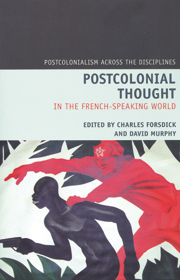Book contents
- Frontmatter
- Contents
- Acknowledgements
- Introduction: Situating Francophone Postcolonial Thought
- Section 1 Twelve Key Thinkers
- 1 Aimé Césaire and Francophone Postcolonial Thought
- 2 Maryse Condé: Post-Postcolonial?
- 3 Jacques Derrida: Colonialism, Philosophy and Autobiography
- 4 Assia Djebar: ‘Fiction as a way of “thinking”’
- 5 Frantz Fanon: Colonialism and Violence
- 6 Édouard Glissant: Dealing in Globality
- 7 Tangled History and Photographic (In)Visibility: Ho Chi Minh on the Edge of French Political Culture
- 8 Translating Plurality: Abdelkébir Khatibi and Postcolonial Writing in French from the Maghreb
- 9 Albert Memmi: The Conflict of Legacies
- 10 V. Y. Mudimbe's ‘Long Nineteenth Century’
- 11 Roads to Freedom: Jean-Paul Sartre and Anti-colonialism
- 12 Léopold Sédar Senghor: Race, Language, Empire
- Section 2 Themes, Approaches, Theories
- Notes on Contributors
- Bibliography
- Index
7 - Tangled History and Photographic (In)Visibility: Ho Chi Minh on the Edge of French Political Culture
from Section 1 - Twelve Key Thinkers
- Frontmatter
- Contents
- Acknowledgements
- Introduction: Situating Francophone Postcolonial Thought
- Section 1 Twelve Key Thinkers
- 1 Aimé Césaire and Francophone Postcolonial Thought
- 2 Maryse Condé: Post-Postcolonial?
- 3 Jacques Derrida: Colonialism, Philosophy and Autobiography
- 4 Assia Djebar: ‘Fiction as a way of “thinking”’
- 5 Frantz Fanon: Colonialism and Violence
- 6 Édouard Glissant: Dealing in Globality
- 7 Tangled History and Photographic (In)Visibility: Ho Chi Minh on the Edge of French Political Culture
- 8 Translating Plurality: Abdelkébir Khatibi and Postcolonial Writing in French from the Maghreb
- 9 Albert Memmi: The Conflict of Legacies
- 10 V. Y. Mudimbe's ‘Long Nineteenth Century’
- 11 Roads to Freedom: Jean-Paul Sartre and Anti-colonialism
- 12 Léopold Sédar Senghor: Race, Language, Empire
- Section 2 Themes, Approaches, Theories
- Notes on Contributors
- Bibliography
- Index
Summary
Culture becomes as much an uncomfortable disturbing practice of survival and supplementarity between arts and politics, past and present, the public and the private.
(Bhabha, 1994: 175)On photography
In a letter dated 6 July 1920, L. Josselme, the head of the Indochinese Postal Control in Marseilles, complains in the following terms about the photograph of Nguyên Ai Quôc he has just received from the Résident Supérieur: ‘elle est absolument invisible, ayant jauni par progression depuis son arrivée’ [it is entirely invisible, having progressively yellowed since its arrival], adding that this deterioration ‘m'oblige à vous demander de vouloir bien m'en adresser un autre exemplaire mieux fixé’ [forces me to ask you kindly to send another more permanent, better fixed copy] (Gaspard, 1992: 101–02). Nguyên Ai Quôc was suspected of being none other than the Nguyên That Tanh who had taken part in a popular uprising against the French in Annam in 1908. The photograph was eagerly awaited to verify and prove his identity. Photography, very early on, had become an integral part of the panoptic apparatus of surveillance deployed by the French Sûreté, both in the colonies and at home, to keep track of potentially dangerous natives. By becoming invisible, the photograph became the failed site of an authoritative marking of the subject's identity.
- Type
- Chapter
- Information
- Postcolonial Thought in the French Speaking World , pp. 102 - 114Publisher: Liverpool University PressPrint publication year: 2009

